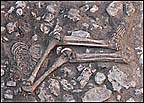 The practice of human sacrificial burials in Egypt, presumably to coincide with the pharaoh's own funeral, had long been suspected but never substantiated. Now it has been for the first time, and Dr. David O'Connor of New York University's Institute of Fine Arts said the discovery was 'dramatic proof of the great increase in the prestige and power of both kings and the elite' as early as the first dynasty of the Egyptian civilization, beginning about 2950 B.C.
The practice of human sacrificial burials in Egypt, presumably to coincide with the pharaoh's own funeral, had long been suspected but never substantiated. Now it has been for the first time, and Dr. David O'Connor of New York University's Institute of Fine Arts said the discovery was 'dramatic proof of the great increase in the prestige and power of both kings and the elite' as early as the first dynasty of the Egyptian civilization, beginning about 2950 B.C.
A discovery team, organized by N.Y.U., Yale and the University of Pennsylvania, found six graves next to the ruins of a mortuary ritual site dedicated to the departed Aha, the first pharaoh of the first dynasty, and not far from his tomb. Five of the graves have been excavated, yielding skeletons of court officials, servants and artisans that appear to have been sacrificed to meet the king's needs in the afterlife.
Although the graves at the Aha site were separate, their wooden roofs were covered by a continuous mud plaster layer applied at about the same time that the adjacent mortuary ritual structure was erected. "This makes a strong case," Dr. O'Connor said, "that all these people died and were put in the graves at the same time."
No comments:
Post a Comment